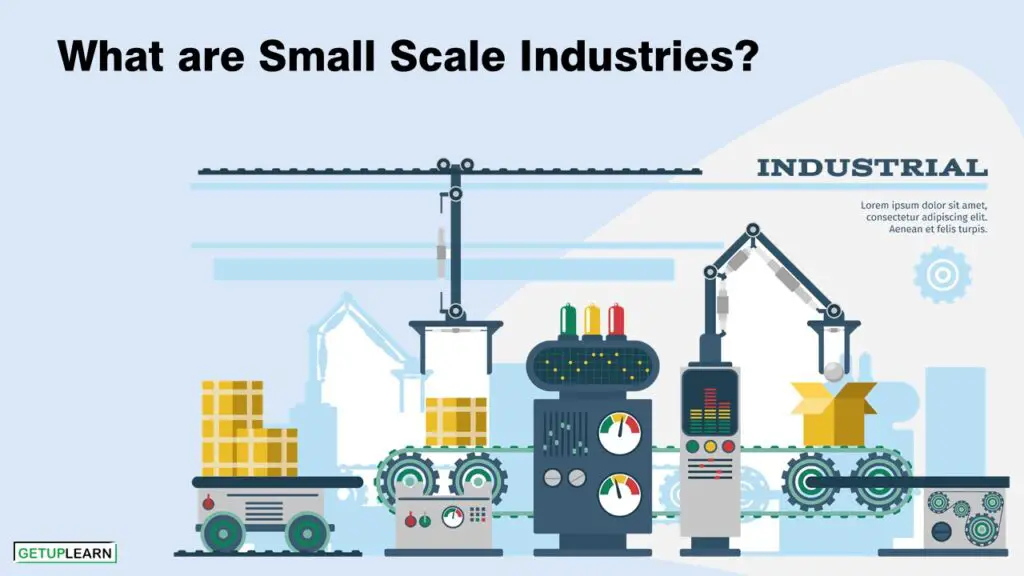Table of Contents
What are Small Scale Industries?
Small Scale Industries (SSIs) in India are businesses characterized by relatively small investments in machinery, equipment, and plant, and with a relatively low volume of output compared to larger-scale enterprises. These industries play a crucial role in the Indian economy by contributing significantly to employment generation, industrial production, and export earnings.

Small-scale industry comprises a variety of undertakings. The definition of small-scale industry varies from one country to another and from one time to another in the same country depending upon the pattern and stage of development, Government Policy, and administrative setup of the particular country.
As a result, there are nearly 50 different definitions of SSIs found and used in 75 countries. All these definitions either relate to capital employment or both or any other criteria. There can be two bases for defining small business and these are:
- Scale of Business
- Qualitative Aspects
Scale of Business
The size or scale of a business can be measured in various ways:
-
Investment in plant and machinery
- Employment generation.
- Investment and Employment
- Volume and/or value of production
- Volume and/or value of sales.
Qualitative Aspects
- Ownership of small businesses is in the hands of an individual or a few individuals.
-
Management and control of small-scale firms is with the owner or owners.
- The technology adopted in small-scale units is normally labor-intensive.
- Small-scale business is normally carried on in a limited or local area
Types of Small Scale Industries
These are the three major types of small-scale industries explained below:
- Tiny Industries
- Ancillary Units
- Cottage Industries
Tiny Industries
Very small industries with an investment of less than Rs. 25 lakhs are included in the category of Tiny industries. Capital investments for this purpose means investment in plant and machinery. The location restrictions or the setting up of Tiny Units have been removed by the Small Industries Policy of 1992.
The number of persons employed in these units must be less than 50. These units are normally operated under a sole proprietorship form of ownership. These units are managed by family members and not professionals which results in lower profit generation.
Ancillary Units
Industrial units having an investment in plant and machinery, whether held on ownership or by lease or by hire purchase does not exceed Rs. 1 crore and engaged or is proposed to be engaged in the manufacture or production of parts, components, sub-assemblies, tooling, and intermediaries, or the rendering of service and supply or render at least 50 percent of its production or services as the cases may be to one or more other industrial undertakings.
Cottage Industries
These are also called household industries. They are organized by individuals and with the help of members of the household (including family labor) and are pursued as full-time or part-time occupations.
The capital investment is small and the components used are simple. These industrial units normally use local resources and local skills. The output produced in each industrial unit is generally sold in the local market.
Features of Small Scale Industries
The following are the features of small scale industries:
- Ownership
- Management and Control
- Gestation Period
- Area of Operation
- Technology
- Resources
- Dispersal of Units
- Flexibility
Ownership
Ownership of a small-scale unit is with one individual in sole proprietorship or it can be with a few individuals in partnership.
Management and Control
A small-scale unit is normally a one-man show and even in the case of a partnership the activities are mainly carried out by the active partner and the rest are generally sleeping partners. These units are managed in a personalized fashion. The owner is actively involved in all the decisions concerning business.
Gestation Period
The gestation period is the period after which teething problems are over and the return on investment starts. The gestation period of small-scale units is less as compared to large-scale units.
Area of Operation
The area of operation of small-scale units is generally localised catering to the local or regional demand. The overall resources at the disposal of small-scale units are limited and as a result of this, it is forced to confine its activities to the local level.
Technology
Small industries are fairly labor intensive with comparatively smaller capital investments than larger units. Therefore these units are more suited for economies where capital is scarce and there is an abundant supply of labour.
Resources
Small-scale units use local or indigenous resources and as such can be located anywhere subject to the availability of these resources like labor and raw materials.
Dispersal of Units
Small-scale units use local resources and can be dispersed over a wide territory. The development of small-scale units in rural and backward areas promotes more balanced regional development and can prevent the influx of job seekers from rural areas to cities.
Flexibility
Small-scale units as compared to large-scale units are more change-susceptible highly reactive and responsive to socioeconomic conditions. They are more flexible to adopt changes like new methods of production, introduction of new products, etc.
Objectives of Small Scale Industries
The small-scale sector can stimulate economic activity and is entrusted with the responsibility of realizing the following objectives:
- To create more employment opportunities with less investment.
- To remove the economic backwardness of rural and less developed regions of the economy.
- To reduce regional imbalances.
- To mobilize and ensure optimum utilization of unexploited resources of the country.
- To improve the standard of living of people.
- To ensure equitable distribution of income and wealth.
- To solve the unemployment problem.
- To attain self-reliance.
- To adopt the latest technology aimed at producing better quality products at lower costs.
Relationship Between Small and Large Industries
After going through the distinct characteristics of small-scale industries, one should not assume that both small and large, are antithetical to each other. In other words, both cannot be sustained in an economy.
But, the fact is that one is complementary to the other. The relationship between the small and the large industrial units can be seen in various respects, which are stated below:
- Supplementary
- Complementary
- Competitive
- Servicing
- Initiative
Supplementary
Small industries can fill in the gaps between large production and standard outputs caused by large-scale industries. This is due to this supplementary role of small industries that a small tricycle factory sustained and flourished alongside a large cycle factory in Chennai city.
Complementary
Apart from supplementary relationships, the small industry has been complementary to its large counterparts. In the real world, many small units produce intermediate products for large units. Such a subcontracting relationship between the small and large was particularly marked in the economic history of today’s industrially developed Japan.
As industrialization proceeds, small firms seem naturally to shift from activities that compete with large firms to complementary ones. Similarly, China too continues to rely on Mao’s aphorism of “walking on two legs” – one being small and the other large.
Under a complementary relationship, small units function under the tutelage of the large units and enjoy the advantage of a protected market for their products then, the flourishment of such small units remains beyond doubt.
Competitive
Though Small-scale industries cannot compete with large industries in certain circumstances and in selected products, they have a comparative advantage in some products.
Examples of such industries are bricks and tiles, fresh baked goods and perishable edibles, preserved fruits, goods requiring small engineering skills, and items demanding craftsmanship and artistry.
Servicing
Small industries do also install servicing and repair shops for the products of large units. In the case of India, such small servicing units can be seen proliferating in respect of large industries like refrigerators, radio and television sets, watches and clocks, cycles, and motor vehicles.
Initiative
Attracted by the high profits of large units, small units can also take the initiative to produce a particular product. If succeeds, the small unit grows too large over a period of time.
Staley quotes such initiation that many of the automobile factories started this way in the United States of America. In our country too, the electronic industry looks like following this initiative pattern of development.
Importance of Small Scale Industries
Let us now discuss the various advantages of small scale industries to highlight the importance of this sector. The main advantages are as follows:
- Generation of Employment
- Self Employment
- Lesser Capital Requirement
- Mobilization of Capital
- Mobilization of Entrepreneurial Skill
- Equitable Distribution of Income
- Balanced Regional Development
- Saving in Foreign Exchange
- Quick Investment
- Other Advantages
Generation of Employment
The small-scale industries are labor intensive i.e. the ratio of labour to investment is very high in their case. A given amount of capital invested in a small-scale industry provided more employment than the same amount of capital invested in a large-scale industry.
Since capital is scarce and labor abundant in India, the generation of employment is the advantage that can be put forward for the support of small-scale industries in India.
Self Employment
The small-scale industries offer almost limitless opportunities for self-employment and hence are particularly suited to a developing country like India where there is a big problem of unemployment and underemployment.
Lesser Capital Requirement
Another advantage of small-scale industries is that they need a relatively lesser amount of capital than that required by large-scale industries. As capital is very scarce in an underdeveloped country like India, it may be used to greater advantage in the small-scale sector.
Mobilization of Capital
Small-scale industries not only make economies in the use of capital but also mobilize capital that would not otherwise have come into existence. Large-scale industries cannot mobilize the savings from rural areas, while this task can be effectively accomplished by setting up a network of small-scale industries in such areas.
Mobilization of Entrepreneurial Skill
Another advantage of small-scale industries is the lesser requirement of skill and expertise, which is also scarce in a developing country like India.
Further, large-scale industries cannot utilize a number of entrepreneurs who are spread over small towns and villages of the country. On the other hand, small-scale industries can effectively mobilize such entrepreneurial skills.
Equitable Distribution of Income
Small-scale industries secure a more equitable distribution of income and wealth. They are particularly suitable for the fulfillment of the objective of social justice.
This is ensured because the ownership of small-scale industries is more widespread and they offer a much longer employment potential as compared to the large-scale industries. The development of large-scale industries tends to concentrate large incomes and wealth in a few hands.
Balanced Regional Development
Small-scale industries utilize local resources, bring about the dispersion of industries, and promote balanced regional development. The growth of large-scale industries on the other hand has a tendency towards concentration of industries in a few places leading to many evil consequences such as overcrowding, pollution, creation of slums, etc.
Saving in Foreign Exchange
Another advantages of the small-scale industries are the savings they offer in the scarce foreign exchange resources of the country.
Firstly, small-scale industries do not require much foreign exchange resources for their establishment and secondly, these industries can contribute to the foreign exchange resources of the country by adding to exports.
Quick Investment
The time lag between the execution of investment projects and the start of production of goods is relatively short in the case of small-scale industries. These quick investment types of industries are particularly suitable for developing countries like India.
Beneficial to large-scale industries: Large-scale industries can also prosper and develop if small-scale industries manufacture and supply their small parts and semi-finished goods required by them. In fact, small-scale industries are a must for the development of large-scale industries.
Other Advantages
These industries also confer certain other social and political benefits such as overcoming territorial immobility, reduction of pressure on land, relieving congestion in urban areas, self-employment, etc.
FAQs Section
What are the features of small scale industries?
The following are the features of small scale industries:
1. Ownership
2. Management and Control
3. Gestation Period
4. Area of Operation
6. Technology
7. Resources
8. Dispersal of Units
9. Flexibility.
What are the importance of small scale industries?
The importance of small scale industries are explained below:
1. Generation of Employment
2. Self Employment
3. Lesser Capital Requirement
4. Mobilization of Capital
5. Mobilization of Entrepreneurial Skill
6. Equitable Distribution of Income
7. Balanced Regional Development
8. Saving in Foreign Exchange
9. Quick Investment
10. Other Advantages.





